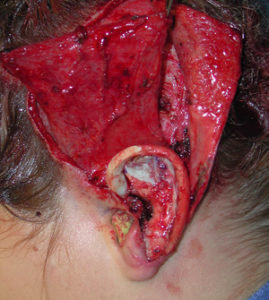Loss of the ear through either traumatic amputation or from tumor resection poses major reconstructive challenges. There is not only the replacement of the supporting ear cartilage that is responsible for making the ear look like an ear. But there is also the replacement of the lost skin that covers the underlying ear framework. The latter is more challenging then the former.
The choice of an ear framework replacement always comes down to either that of an intraoperatively assembled rib graft construct or a preformed synthetic Medpor framework. Each method has their own distinct advantages or disadvantages. In the older patient where the rib cartilages are more calcified, a synthetic ear framework creates a more reliable ear shape.
But the real challenge in recreating a vascularized soft tissue cover over whatever framework is chosen. Without a living skin cover that has some thickness, the choice of ear framework reconstruction is irrelevant. Any exposure of an ear framework, even that of rib cartilage, will result in infection and loss of it.

The TPF flap works because the incoming vascular supply comes in inferiorly allowing the flap to be safely turned down over the ear framework and it still remains alive.
Dr. Barry Eppley
Indianapolis, Indiana


